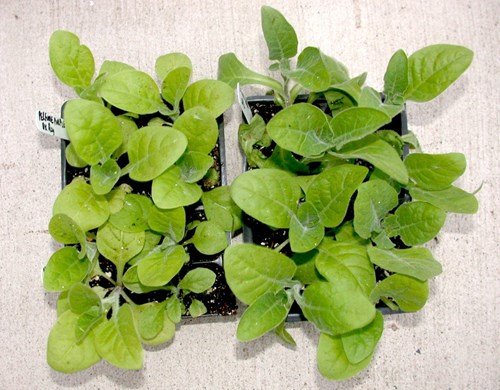How Can Mycorrhizae Help Your Crops?


Over the past decades, there has been a growing interest in beneficial soil organisms among plant scientists. Studies have shown that many of these naturally occurring bacteria and fungi help plants combat diseases, locate nutrients, and acquire water when in short supply to improve and enhance plant growth.
This has led to the capture and culture of various beneficial organisms that consumers and growers can use to inoculate and enhance their crops.
Within the beneficial organism family exists a complex group called mycorrhizal fungi. These fungi grow in association with most plants and have been identified as growth and quality enhancers for many crops.
What is Mycorrhiza?
Mycorrhiza (singular) is a term that means “fungus root” and describes the mutually beneficial, symbiotic relationship between fungi and plant roots.
Most mineral soils contain mycorrhizal fungi, but often at levels that are too low for adequate colonization. This is especially true in depleted soils such as tilled fields, newly planted gardens, overworked landscapes, and new housing development plots.
How Do Mycorrhizae Work?
Mycorrhizal fungi are host-specific and will only colonize certain plants. This means that in some soils, there may no longer be native mycorrhizae present to benefit what you are about to plant.
Therefore, most plants benefit from the addition of mycorrhizae to the soil. In growing media, adding mycorrhizae becomes even more critical.
Most soilless media are composed of peat moss, coco coir, perlite, bark and expanded clay pebbles that are void of mycorrhizal fungi. This means that plants cannot benefit from mycorrhizal fungi unless they are incorporated into growing media.
How Does Symbiosis Work?
Symbiosis begins when fungal spores germinate, and emerging threadlike structures called hyphae enter the epidermis of plant roots.
After colonizing the roots, the fungus sends out a vast network of hyphae throughout the soil to form a greatly enhanced, absorptive surface area (Figure 1). This results in improved nutrient acquisition and uptake by plant roots.
Mycorrhizae are particularly effective in mobilizing elements like phosphorus, zinc, manganese and copper. In exchange for nutrients, the plant provides carbohydrates for the fungi, meaning that both species benefit from this association.

There are more than 150 species of mycorrhizal fungi found in all types of soils and climates around the world. There are several general classes used to categorize mycorrhizal fungi, but the two most common classes are called ectomycorrhiza and endomycorrhiza.
Why Do Our Products Contain Endomycorrhizae?
Endomycorrhizae are the most beneficial for herbaceous greenhouse-grown plants. They help plants by reducing symptoms associated with stress.
The benefits of growing with mycorrhizae include:
Reduced Nutritional Deficiencies
Endomycorrhizae explore the growing medium where plant roots are not present to acquire nutrients like phosphorus, copper, manganese, and zinc.
They then deliver the nutrients they find to the plants, minimizing nutrient deficiencies (Figure 2).

Reduction in fertilizer use
Since endomycorrhizae explore the growing medium for fertilizer elements, many growers find that they can reduce fertilizer application rates. Mycorrhizae make better use of nutrients found throughout the growing medium.
Delayed wilting
Endomycorrhizae acquire water from the growing medium where plant roots may not be able to access it. This additional water delays or prevents wilting from water stress.
Improved growth
When plants obtain the nutrients they need, they maintain their optimal growing rates longer. Therefore, overall plant growth is improved (Figures 3 and 4).

Resistance to salt toxicity
Numerous studies have shown that endomycorrhizal fungi protect plants from high levels of salt in the soil and micronutrient toxicities.
Reduced root disease attacks
Endomycorrhizal fungi make plants less susceptible to attack by root-rot pathogens. They do so in two ways: first, they compete against root-rot pathogens by consuming root exudates such as carbohydrates. Second, they help thicken the cell walls of the root cortex, making pathogen penetration more difficult.
Increased fruits and flowers
Since plants grow to their fullest potential with endomycorrhizal fungi, they produce more vegetables/fruits per plant, and/or larger vegetables/fruits.
Flowering plants often produce more flowers. Overall, plants often grow more vigorously when colonized by endomycorrhizal fungi, especially if they have been planted into poor-quality, low-fertility soils.
In summary, endomycorrhizae assist plants by enhancing plant nutrient and water uptake, reducing environmental stresses, and improving the overall growth of plants.
When plant roots form an association with mycorrhizal fungi, the mycorrhizae remain with the plant for its entire life and provide continuous benefits.
Numerous studies have demonstrated benefits for plants used for land reclamation, landscape installations, home gardening, fruit and vegetable crops, and greenhouse/nursery crops. These benefits contribute to improved efficiencies in plant production and reduce plant production costs for growers.